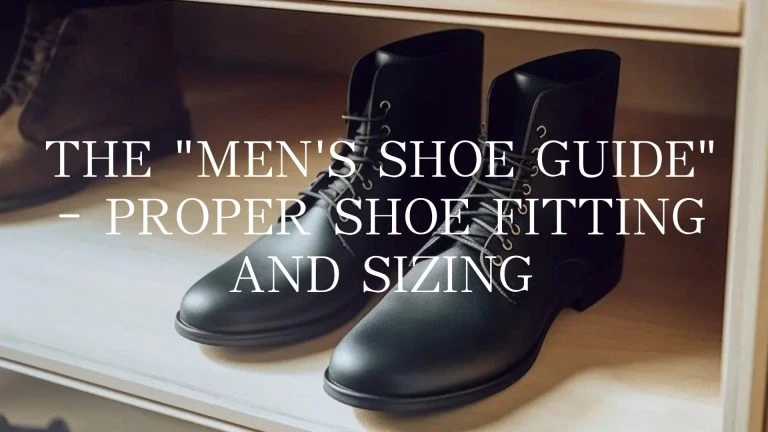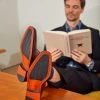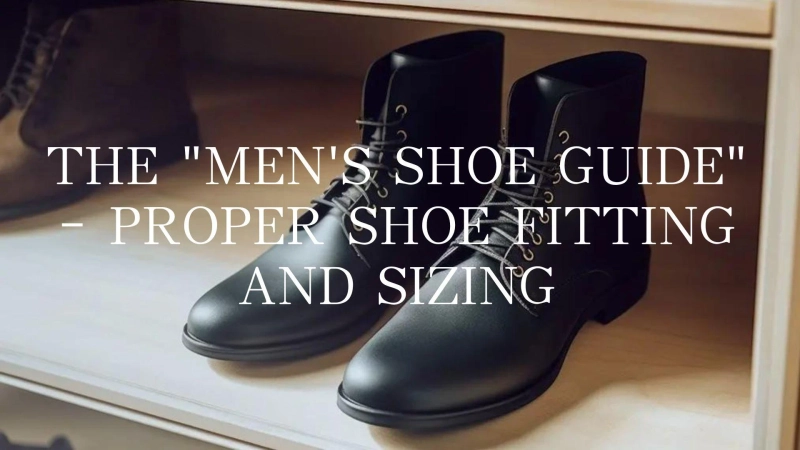 In this comprehensive guide, you\'ll learn everything you need to know about properly fitting and sizing your shoes, from using a Brannock device to understanding foot anatomy and how it impacts shoe fit. Whether you\'re buying shoes online or in-store, this guide will ensure you find the perfect pair that provides comfort and support.
In this comprehensive guide, you\'ll learn everything you need to know about properly fitting and sizing your shoes, from using a Brannock device to understanding foot anatomy and how it impacts shoe fit. Whether you\'re buying shoes online or in-store, this guide will ensure you find the perfect pair that provides comfort and support.
Table of Contents
- The Brannock Device: History and Usage
- Sizing Based on Occupation and Travel
- Measuring Feet with Cobbler Bob
- Measuring Feet with Zach
- Arch Types and Foot Mechanics
- Toe Cap Creasing and Heel Fit
- Supination, Back Pain, and Knee Issues
- The Oxford Vee and Closing the Laces
- Buying Shoes Online and Brannock Sizing
- Weight, Alignment, and Shoe Fit
- Comparing Shoe Last Shapes and Styles
- The Gifennse 10-Point Fit Test
- Breaking in New Leather Shoes
The Brannock Device: History and Usage
The Brannock device, patented by Otis Brannock in 1927, revolutionized the standardization of shoe sizing in the footwear industry. Before its invention, shoe sizing was inconsistent and varied widely. The Brannock device provided a 95 to 96 percentile accuracy in sizing, establishing a standard measurement system for the entire industry. It uses a men\'s size one as the starting point, which measures seven and two-thirds inches, with each full size increment being a third of an inch and each half size being six of an inch. Additionally, width is indicated by adding 3/16 of an inch for every width increase or decrease in the U.S. sizing system.
Usage of the Brannock Device
The Brannock device is available in men\'s, women\'s, and unisex models, with variations in width from B (women\'s medium) to E (Triple E). It remains an essential tool for accurately measuring foot length and width to determine the proper shoe size and width for individuals.
Sizing Based on Occupation and Travel
Occupation and travel can significantly impact foot size and width. For individuals with jobs that involve prolonged standing or walking, such as pharmacists, foot size can fluctuate throughout the day due to swelling. It\'s not uncommon for individuals in such professions to experience a half to a full-size increase in foot dimensions. Similarly, frequent air travel can cause feet to swell, requiring individuals to consider this factor when selecting shoes for travel. Additionally, it\'s essential to account for potential foot swelling when traveling overseas, as it may take several days for the feet to return to their normal size after extended flights.
Measuring Feet with Cobbler Bob
When measuring feet, it\'s essential to consider various factors such as toe length, arch length, and foot width. I recently had the opportunity to observe Cobbler Bob, an experienced professional, measure an individual\'s feet using a Brannock device. Here\'s a breakdown of the process:
Toe Length and Arch Bar
- Utilize the Brannock device\'s numbering system to measure toe length and identify the natural flex point of the foot.
- Position the arch bar in line with the ball of the foot to ensure it cradles the inside, indicating the natural flex point.
Foot Width Considerations
- When measuring foot width, it\'s crucial to account for the foot\'s muscular, bony, or fleshy nature, as well as the volume and circumference of the foot.
- Adjust the width measurement based on the individual\'s foot characteristics, ensuring a comfortable and proper fit.
Interpreting Measurements for Shoe Selection
Understanding the significance of toe length, arch length, and foot width measurements is pivotal in selecting the right shoe size and width. Cobbler Bob emphasized the importance of considering the natural flex point for various types of shoes, especially running shoes, and how foot volume impacts the overall fit.
Measuring Feet with Zach
Following the insightful session with Cobbler Bob, I had the opportunity to witness another foot measurement process conducted by an individual named Zach. Here\'s a breakdown of the measurement process and considerations:
Toe Length and Arch Length Assessment
- Accurately measure the toe length, ensuring the natural flex point and accommodating for any differences in toe sizes.
- Evaluate the arch length to determine the starting point for selecting the appropriate shoe size and width.
Foot Width Evaluation and Shoe Fitting
- Consider the foot\'s width and characteristics, such as high arches or wide toe boxes, to determine the suitable shoe width.
- Select the shoe size and width based on the arch length and foot volume, ensuring a comfortable and accommodating fit.
Understanding Individual Foot Characteristics
Observing the foot measurement process with Zach highlighted the unique characteristics of each individual\'s feet and the importance of selecting shoes that cater to specific foot dimensions, arch lengths, and widths. The process emphasized the significance of addressing individual foot variations for optimal shoe fit and comfort.
Arch Types and Foot Mechanics
Understanding foot anatomy and mechanics is essential for selecting the right shoes that provide optimal comfort and support. The arch of the foot plays a significant role in determining the type of shoes that best suit an individual\'s feet. High arches, characterized by a prominent instep, require specific shoe designs to accommodate the elevated structure. Conversely, individuals with low arches or flat feet, tend to pronate, leading to increased pressure on the inside of the foot. It\'s crucial to recognize these variations in arch types and their impact on foot mechanics to ensure proper shoe selection and fit.
Pronation and Supination
Understanding pronation and supination is key to identifying how the foot moves within the shoe. Pronation, often associated with lower arches, involves the inward rolling of the foot, leading to increased pressure on the inside. Conversely, supination, typical of higher arches, results in the outward rolling of the foot, exerting pressure on the outer edge. Recognizing these foot movements is essential for selecting shoes that provide adequate support and prevent discomfort or pain associated with improper foot mechanics.
Toe Cap Creasing and Heel Fit
Toe cap creasing and heel fit are crucial aspects to consider when assessing the suitability of shoes for an individual. Understanding the significance of toe cap creasing and heel fitment provides valuable insights into the overall comfort and appropriateness of the shoe size and design. By examining these factors, individuals can make informed decisions when selecting shoes that cater to their specific foot characteristics and mechanics.
Supination, Back Pain, and Knee Issues
Understanding supination is crucial as it can lead to back pain and knee issues. Supination, which involves the outward rolling of the foot, exerts pressure on the outer edge, potentially causing discomfort and pain. Individuals experiencing supination may notice increased soreness on the outside of their feet during activities such as walking or running. Addressing supination is essential to prevent potential musculoskeletal issues and ensure overall foot health.
The Oxford Vee and Closing the Laces
When discussing the Oxford Vee and closing the laces, it\'s important to consider both aesthetics and structural fit. The width of the Vee in the shoe plays a crucial role in ensuring a proper fit. Initially, a wider Vee allows for potential stretching as the shoe is worn and broken in. However, the ability to adjust the Vee\'s width can cater to individual preferences and foot characteristics. Additionally, understanding how to close the laces effectively contributes to achieving a secure and comfortable fit, aligning with personal style and ensuring optimal structural support.
Buying Shoes Online and Brannock Sizing
Buying shoes online can be a convenient option, but ensuring the right fit poses a challenge. Understanding Brannock sizing and its significance is crucial for making informed online purchases. The Brannock device serves as a standard measurement tool, providing accurate foot length and width measurements. By comprehending the implications of Brannock sizing, individuals can make informed decisions when ordering shoes online, ultimately ensuring optimal fit and comfort.
Weight, Alignment, and Shoe Fit
Impact of Weight on Shoe Fit
Weight fluctuations can affect foot dimensions and shoe fit. Increased weight may lead to foot widening and arch lengthening, necessitating adjustments in shoe size and width. Conversely, weight loss may result in foot narrowing and arch shortening, influencing the selection of appropriate shoe dimensions. Understanding the impact of weight on shoe fit is essential for addressing potential fitment issues and ensuring comfort.
Alignment and Foot Mechanics
Proper foot alignment is crucial for overall musculoskeletal health. Misalignment, such as supination or pronation, can lead to back and knee issues. Recognizing the impact of foot mechanics on alignment and posture is pivotal for selecting shoes that provide adequate support and stability. By addressing alignment concerns, individuals can mitigate potential discomfort and maintain optimal foot health.
Comparing Shoe Last Shapes and Styles
When it comes to choosing the right pair of shoes, understanding the significance of shoe last shapes and styles is essential. Each last is designed with unique characteristics, particularly in the toe box, toe spring, and heel spring, impacting the overall fit and comfort. It\'s crucial to recognize that the form on which a shoe is constructed, akin to an individual\'s foot, varies across different brands and models. Therefore, it\'s advisable not to fall in love with a shoe solely based on its appearance, as the last\'s design may not necessarily correspond to one\'s foot shape and size. To ensure a proper fit, it\'s imperative to try on shoes and assess their compatibility with individual foot dimensions and characteristics. Additionally, considering the evolution of shoe styles over time, such as changes in pant legs and hemlines, emphasizes the need to prioritize comfort and fit over aesthetic appeal when selecting footwear. Always remember that trying on shoes is the most reliable way to determine the perfect fit, considering the variations in sizing between manufacturers and across different shoe models.
The Gifennse 10-Point Fit Test
When it comes to ensuring the ideal fit for your shoes, the Gifennse 10-Point Fit Test serves as a comprehensive guide. This test encompasses various critical aspects that directly influence the comfort and suitability of a pair of shoes. From assessing the length and width fit to evaluating the heel slip and top line fit, each point in the test plays a crucial role in determining the overall comfort and compatibility of the shoes with an individual\'s foot dimensions and characteristics. Understanding and implementing the 10-Point Fit Test is instrumental in making informed decisions when selecting and trying on shoes, ensuring that they meet the necessary criteria for optimal fit and comfort.
Breaking in New Leather Shoes
Breaking in new leather shoes is a process that requires patience and dedication to achieve optimal comfort and fit. When acquiring a new pair of leather shoes, it\'s essential to allow ample time for the insole cork bed to mold to the shape of your feet. This process typically takes several days of consistent wear, with the heat generated during use facilitating the formation of the cork bed. It\'s advisable to avoid extended walks or strenuous activities during the initial breaking-in period to prevent discomfort and potential rubbing. Additionally, carrying flexible fabric band-aids can provide relief for any unexpected pressure points or friction. Remember, the investment of time and patience in breaking in new leather shoes ultimately leads to long-term comfort and satisfaction.


